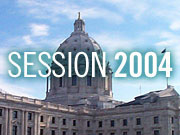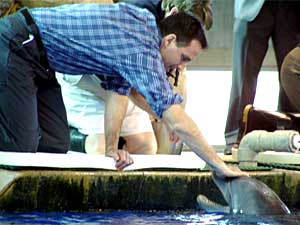Photos
More from MPR
Resources
Your Voice
| |||||||||||||||||||||||||||||||||||||||||||||
Pawlenty proposes ag, environment, and zoo bonding
January 12, 2004
Governor Pawlenty Monday laid out more details of his 2004 state bonding request. The governor expanded his list of projects by pledging $25 million to the Minnesota Zoo, $18 million to agricultural loans, and $147 million to a basket of environmental initiatives. The announcements bring the governor's wish list to just under $400 million. But some say that's still not enough.
St. Paul, Minn. — Gov. Pawlenty spent his morning at the Minnesota Zoo's Discovery Bay. With the zoo's five dolphins as backdrop, the governor offered for the state to borrow $25 million to preserve the zoo's existing assets and build a new exhibit spotlighting life on Russia's Pacific Coast. Pawlenty says supporting a world-class zoo is important to the state's image.
"It's a fabric. You know, it's a quilt. It's a quality-of-life quilt, and it involves many pieces. And you have to address them as best you can at the same time," Pawlenty says." "And different people need and enjoy different things. And you have to make sure you have a balanced perspective."
Zoo director and CEO Lee Ehmke says Pawlenty's proposal far exceeds any bonding money the 25-year-old institution has ever received.
"This dwarfs even the original bond that built the zoo back in the '70s. This is the biggest in history," says Ehmke.
In addition to the borrowed dollars, the state would also assume the zoo's $9.2 million debt left over from the construction of Discovery Bay.
The zoo bonding proposal was greeted with enthusiasm, but another plan is receiving a little cooler reception. Pawlenty has proposed $147 million in environmental initiatives. That includes money for wastewater treatment improvements, flood mitigation, and landfill cleanup.
|
Minnesota must make a strong commitment to improve and protect its natural resources. From planting new trees
to cleaning up our waters, these projects are important steps toward achieving an excellent environmental standard for future generations.
- Gov. Tim Pawlenty |
Anne Hunt of the Minnesota Environmental Partnership says she's pleased with many of those projects, but she says it only goes two-thirds of the way towards a complete clean water package.
"There needs to be monies for local communities to either clean up problem areas, or be able to purchase or set aside very sensitive land areas," says Hunt.
The enviromental plan also includes $22 million for the Conservation Reserve Enhancement Program. CREP, -- as it's called -- would pay farmers to take 100,000 acres of marginal but environmentally sensitive farmland out of production, thereby reducing erosion and agricultural run-off from polluting waterways. Hunt says she applauds that part of the package.
Farm groups, too, have been mostly supportive of CREP. But there remains disagreement over whether land taken out of production should remain so permanently, or for a fixed but temporary period. Doug Peterson, president of the Minnesota Farmers Union, says he wants to cap the permanent easements at 20 percent of the program's total acreage. Peterson says taking too much land out of production forever could adversely affect rural communities.
"If you take the land out of production, you also take people off of Main Street," says Peterson. "They don't have the ability to have that farm implement dealership. And if you've been out in rural Minnesota, a lot of our smaller dealerships have closed, because we don't have enough farmers to buy the implements to keep those shops open and running."
Peterson, however, generally approved of the governor's plan to offer an additional $18 million in loans to family farmers and small agri-business operations. The loans would help newcomers start their operations or allow existing farmers to expand.
The zoo, the environment, and the farms proposals follow a week of other bonding request announcements that included new prison space for sexually-violent offenders, more supportive housing for the chronically homeless, and improved facilities at state colleges and universities across the state.
Unlike predecessors who have generally released all of their bonding requests at once, Pawlenty has chosen to introduce his major bonding initiatives one at a time. Carleton College political scientist Steven Schier says that strategy keeps the governor in the headlines and gives him maximum exposure. Schier says, by contrast, Pawlenty released last year's budget cutting plan in one press conference.
"In that situation, the governor puts it all out at once and doesn't highlight the specific decisions. Why? Because those decisions are likely to be unpopular," says Schier. "These decisions, which involve showering benefits on particuar parts of the citizenry, are likely to be popular. So you slow it down, you take it piece-by-piece, and put a spotlight on it."
Schier says the governor's strategy is part of a clear political calculus -- but he says it also give citizens more time to study and digest his plans.
The road show continues Tuesday when Pawlenty reveals his transportation and transit plans in Anoka.
|
News Headlines
|
Related Subjects
|


